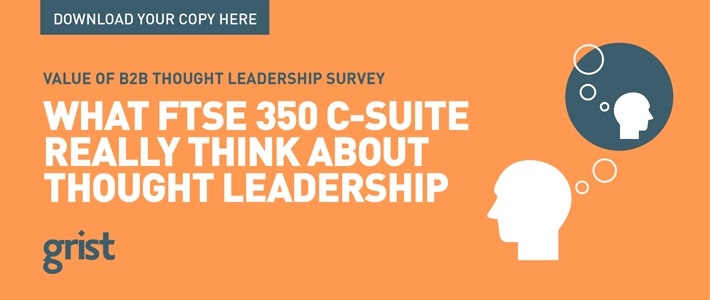Forward-thinking B2B firms are using interviews, surveys and editorial advisory panels to improve their content marketing programmes.
Here’s an opportunity that shouldn’t be spurned. The very people that you are trying to reach through your content marketing programmes are willing to be active participants in the process. To be clear: your clients want to become co-creators.
How do we do know this for sure? Because they told us.
In the Grist Value of B2B thought leadership survey C-suite respondents from FTSE 350 firms were asked what type of content would prove most useful in the future. An astounding 80 per cent said they wanted to read, watch and listen to material that they – and their peers – were involved in developing. Presented with such an invitation, it would be impolite to turn it down.
There are three core ways to involve them:
1. As an interviewee
Interviewing clients as part of the content creation process is a great way to get up close and personal with an existing client or future prospect. Face time with client and an end product, be that articles, case studies or client profiles.
However, the interview must be handled with care. Treat the client with respect by sharing the purpose of the interview, intended outputs and questions ahead of time and detailing how the approvals process will work. And approach the task with journalistic rigour. Do your research and have an idea of the story you want to tell before you start. And, as we’ve pointed out before, ask open-ended questions – of the Who? What? When? Where? Why? How? variety – rather than those that will merely elicit a ‘yes’ or ‘no’ answer.
Finally, try to conduct the interview face-to-face if possible. It will add ‘colour’ to the finished article, enabling you to describe what you see as well as what you hear. Moreover, the more time you spend in the client’s company the better chance you have of creating a positive and lasting impression.
2. As a survey respondent
Client surveys do three things really well. They support business development activities, raise awareness and generate new insights. And to generate truly useful insights means talking to clients and prospects to discover what matters to them.
The ‘finding out’ survey has another big advantage in that it allows you to engage more directly with clients and prospects post survey. As my colleague Mark Wellings noted in a previous blog post, this effectively gives you “two bites at this particular cherry. One at the input stage, by involving them in the research itself. And one at the output stage by reaching out to them with the results.”
Historically some of our clients have worried about survey fatigue – claiming their senior clients don’t fill out surveys any more. We would counter this argument with the results of our own survey which captured the views of 210 FTSE 350 respondents, or if further proof is needed, check out PwC’s CEO survey which explored the views of nearly 1,400 CEOs from the world’s largest companies. Get the subject matter, question set and methodology right and the audience will respond. Get it wrong, and they won’t.
3. As a member of an editorial panel
This is perhaps the most powerful – and underused – option. Create an editorial board or panel to oversee your content marketing output. Led by a key marketing / content marketing executive, the board should feature half a dozen external experts.
That means, chiefly, clients and prospects. Meet quarterly and share your content programme plans with them. Ask for honest feedback and use their expertise to hone ideas and develop new ones. And remember that the value exchange needs to be a fair one. Clients should receive something of value for taking part, an advanced or deeper view of the content created, or access to any underlying data for instance.
It’s possible this last point could turn into something of a land grab. After all, clients can’t sit on the editorial board of all of their advisors. But for those willing to move early, the rewards could be large. After all, they are waiting to be asked.
Those are our recommendations, based on nearly 20 years of creating content for B2B firms. Let us know about your experience involving clients in interviews, surveys and panels. We’d love to hear the good news stories. And the bad.



